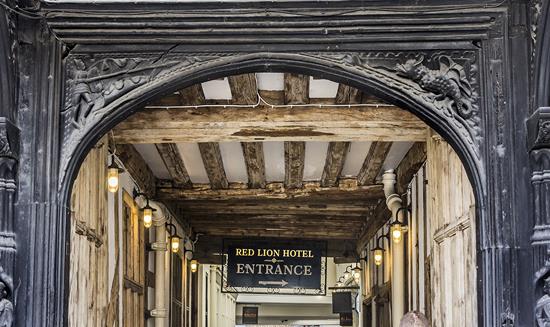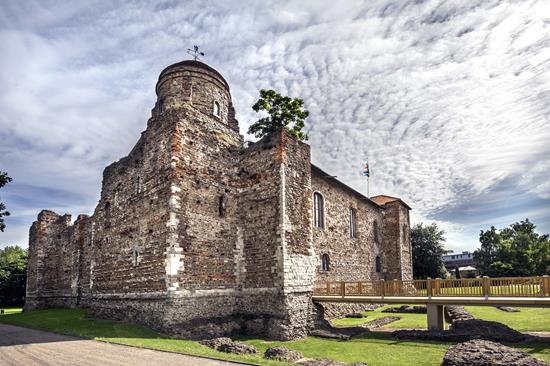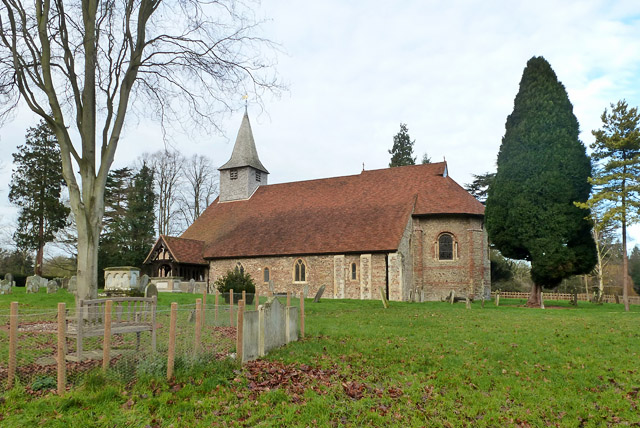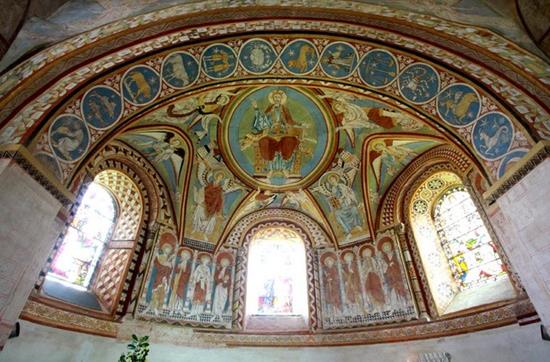Colchester’s Town Wall is the earliest and one of the most complete town wall circuits surviving from Roman Britain, dated to c.AD 65-80. The Wall was constructed in a calcareous mudstone, septaria, imported from an outcrop near Harwich, supplemented by courses of brick. Nearly two thirds of the wall circuit still exists with the remainder surviving as buried archaeological remains; originally the Wall formed a circuit 2.8km long and 2.4m thick, and enclosed a rectangular area of 48ha. Six gates were built in the Wall and internal rectangular towers were constructed on the inside of the Wall; today, there are the upstanding remains of only two gates, the Balkerne Gate and Duncan’s Gate.

A large defensive ditch, over 5m wide and 3m deep, was dug around the outer foot of the Wall, around the same time as the construction of the Wall. This ditch was subsequently recut and enlarged in c.AD 275. An interior rampart was also added to the Wall in the mid-2nd century AD.
The Wall was repaired and refurbished in AD 917 by Edward the Elder. A substantial ditch was cut along the south side of the Wall in the late 10th or 11th century, 7.5m wide and 3.0m deep. An extensive programme of repairs was carried out in the 14th century and eight bastions were added along the south-east circuit. One of the best preserved bastions, Bastion 5, is today situated in Priory Street car park. The Civil War was the last military action seen by the Town Wall.
Unlike many other town walls, subsequent alterations have not altered the essential character of the circuit and it continues to define the historic centre of the town. It is one of the most important historic features and visual reminders of the Roman town, as most of the Roman evidence is buried deep underground.
In 2019, Colchester Borough Council adopted a new management plan. The plan sets out a framework for the maintenance, enhancement, interpretation, presentation and celebration of the Town Wall and its setting.
 The Red Lion Hotel is one of the earliest surviving and best-preserved buildings in Colchester town centre. The Red Lion was built originally as a town house for John Howard, Lord Howard, later the duke of Norfolk in 1481 or 1482 and the heraldic badge of the Howards is carved on the façade, over the gateway.
The Red Lion Hotel is one of the earliest surviving and best-preserved buildings in Colchester town centre. The Red Lion was built originally as a town house for John Howard, Lord Howard, later the duke of Norfolk in 1481 or 1482 and the heraldic badge of the Howards is carved on the façade, over the gateway.
Seventeen samples were taken for tree-ring dating in 2016, from different sections of the building. These indicate, perhaps surprisingly, that different sections were built within a very short timescale. Two posts from the front range provided a date of AD 1475/76 or soon after. A post from the southern hall, in the rear of the west range, was dated to AD 1475 and matched the date of a post at the rear of the east range.
By 1515 it had become a public hostelry, originally the New Inn or The White Lion, but is possible that some of the building complex could have remained in Howard occupation. After 1603, it became known as the Red Lion in honour of James VI of Scotland and I of England, whose Scottish royal arms featured a red lion.
The archway is decorated with St George and the Dragon and two male figures which possibly represent merchants or lawyers. As in previous centuries, today the lower part of the building is used for retail, with the hotel on the upper floors.
 This Norman keep known as Colchester Castle was built around AD 1078 on the foundations of the Roman Temple of Claudius. It was built in at least two main phases and its initial form consisted of a single-storey stone keep with crenellated parapet wall. During the early 12th century, the keep's outer walls were raised by at least one storey and a fore-building was added on the south side to protect the main entrance. A barbican replaced this in the 13th century. The castle's earthwork defences consisted of an upper and 'nether' or lower bailey bank and ditch (to the north, and down-slope to the town wall) with at least one entrance in the upper bailey's south-west corner. The upper bailey defences had been built by 1101. The northern and eastern arms of the upper bailey defences survive as landscaped earthworks within Castle Park. The southern arms lies just to the north of the High Street, and the western arm, below or just to the east of Maidenburgh Street. The nether bailey is possibly part of a second phase, of the late 12th century. The southern end of the eastern arm of the nether bailey survives as a landscaped ditch in Castle Park. The western arm lies below or just to the east of Maidenburgh Street. A masonry chapel and domestic buildings stood to the south of the keep. The keep was partially demolished in the 17th century.
This Norman keep known as Colchester Castle was built around AD 1078 on the foundations of the Roman Temple of Claudius. It was built in at least two main phases and its initial form consisted of a single-storey stone keep with crenellated parapet wall. During the early 12th century, the keep's outer walls were raised by at least one storey and a fore-building was added on the south side to protect the main entrance. A barbican replaced this in the 13th century. The castle's earthwork defences consisted of an upper and 'nether' or lower bailey bank and ditch (to the north, and down-slope to the town wall) with at least one entrance in the upper bailey's south-west corner. The upper bailey defences had been built by 1101. The northern and eastern arms of the upper bailey defences survive as landscaped earthworks within Castle Park. The southern arms lies just to the north of the High Street, and the western arm, below or just to the east of Maidenburgh Street. The nether bailey is possibly part of a second phase, of the late 12th century. The southern end of the eastern arm of the nether bailey survives as a landscaped ditch in Castle Park. The western arm lies below or just to the east of Maidenburgh Street. A masonry chapel and domestic buildings stood to the south of the keep. The keep was partially demolished in the 17th century.
Colchester Castle is now home to Colchester Castle Museum where visitors can explore the Roman vaults and visit the roof of the castle for panoramic views around the town. The museum's collections focus on the history of Colchester and include many very significant finds such as the Kelvedon Warrior and the 'Fenwick hoard', a collection of Roman jewellery found under the Fenwick store on High Street, Colchester.
 Founded between 1093 and 1100, the priory of St Botolph was one of the first religious houses in England to adopt Augustinian rule. It is located on the south-facing slope of a small valley outside Colchester's south-east gateway. It was preceded by an earlier church, which was served by a community of secular canons. The priory church, built in the 12th century (and dedicated in 1177), survives above ground, and there are also below-ground remains of cloistral buildings. The west front contains the traces of the earliest major round window in England, dating from around 1150. The extent of the precinct has not been accurately established.
Founded between 1093 and 1100, the priory of St Botolph was one of the first religious houses in England to adopt Augustinian rule. It is located on the south-facing slope of a small valley outside Colchester's south-east gateway. It was preceded by an earlier church, which was served by a community of secular canons. The priory church, built in the 12th century (and dedicated in 1177), survives above ground, and there are also below-ground remains of cloistral buildings. The west front contains the traces of the earliest major round window in England, dating from around 1150. The extent of the precinct has not been accurately established.
The site is open to the public, and managed by Colchester Borough Council. More information about visiting St Botolph's Priory is available from the English Heritage website.
 Described by Pevsner as 'the most remarkable Norman church in the county', the church of St Michael and All Angels is home to some of the best-preserved Norman wall paintings in Britain.
Described by Pevsner as 'the most remarkable Norman church in the county', the church of St Michael and All Angels is home to some of the best-preserved Norman wall paintings in Britain.
The church was built around 1125-1130, probably as a chapel by the Bishops of London. The whole church was originally vaulted, and the apse still is - Norman vaults in parish churches are extremely rare in England.
The 'Danes skin' from the north door has recently been re-examined and confirmed as human.
 In the apse of the church are mid-12th century wall paintings, much restored, depicting St Michael and St Gabriel and 10 apostles. At the centre is a majesty with rainbow supported by angels. The nave and chancel have numerous figures with extensive decorative work and diaper motifs.
In the apse of the church are mid-12th century wall paintings, much restored, depicting St Michael and St Gabriel and 10 apostles. At the centre is a majesty with rainbow supported by angels. The nave and chancel have numerous figures with extensive decorative work and diaper motifs.
The paintings are by far the most important medieval wall paintings in Essex. They date from the same time as the church, and are comparable with contemporary paintings in St Gabriel's Chapel, Canterbury Cathedral. They have been heavily restored, particularly those in the apse (pictured) which were discovered during restoration work in 1871-2 and over-painted.
This beautiful church is just 5 minutes off the A12 to the south of Colchester, and is open to the public. To find out more about visiting, please check the church website.

 The
The  This Norman keep known as
This Norman keep known as 

 In the apse of the church are mid-12th century wall paintings, much restored, depicting St Michael and St Gabriel and 10 apostles. At the centre is a majesty with rainbow supported by angels. The nave and chancel have numerous figures with extensive decorative work and diaper motifs.
In the apse of the church are mid-12th century wall paintings, much restored, depicting St Michael and St Gabriel and 10 apostles. At the centre is a majesty with rainbow supported by angels. The nave and chancel have numerous figures with extensive decorative work and diaper motifs.